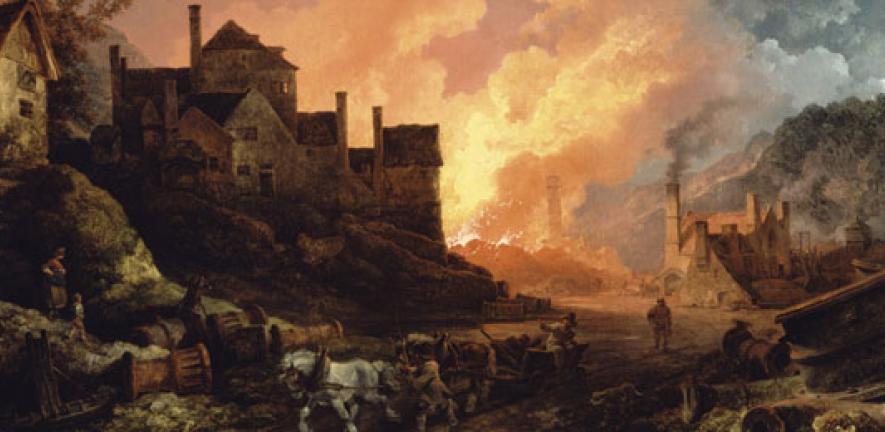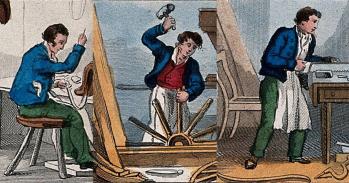
In 2003, researchers embarked on a project to piece together a picture of changes in British working life over the course of 600 years. The emerging results seem to demand a rewrite of the most important chapter in our social and economic history.
In 2003, researchers embarked on a project to piece together a picture of changes in British working life over the course of 600 years. The emerging results seem to demand a rewrite of the most important chapter in our social and economic history.
We're talking about a fundamental change in what we understand about the past
Leigh Shaw-Taylor
There comes a point when talking with Dr Leigh Shaw-Taylor at which it seems necessary to go over the facts again, if only to establish that he really does mean what he appears to have just said.
While many historians will spend their careers chipping away at the past with gentle care, 12 years into his research project, The Occupational Structure of Britain, 1379–1911, Shaw-Taylor seems to be calling for a wholesale rewrite. If his emerging results are correct, then they have the potential to transform not only the most important chapter in our social and economic history – the industrial revolution (so-called) – but with it the wellspring of much of our local and national identity.
So isn’t this a little drastic? “We’re talking about a fundamental change in what we understand about the past,” he says. “That is a fairly widespread view of our work. I’ve always felt that you can do more with historical research than people think, but I never thought that we could do this much. And it’s nothing compared with what we could achieve if we can keep the project going.”
The project, as its name suggests, is a hugely ambitious, wide-scale attempt to reconstruct the picture of how working life changed and developed in Britain from the late Middle Ages through to the early 20th century. Co-directed by Shaw-Taylor and his Cambridge colleague Professor Sir Tony Wrigley, the research team has spent years assembling information about matters such as population size, transport infrastructure and sector-by-sector employment, at different points in time.
It’s a complex job and, before this, nobody had really tried it. Much of what we know about social and economic history is based on records such as wills and parish registers, which are patchy, inconsistent or highly selective. As well as collating information, the team therefore had to develop a method of controlling for this lack of coherence, to avoid distorting the resulting picture of the past. “We had to develop a system of weighting the importance of the data when analysing it,” Shaw-Taylor explains. “We still can’t be sure that it’s right, but it puts a limit on the extent to which we can be wrong.”
Textbook orthodoxy says that, before the industrial revolution, most people in Britain worked in primary sector employment, overwhelmingly in agriculture. During the ‘revolutionary’ 80-year period starting in about 1760, this landscape was transformed as secondary industries – like processing and manufacturing – took off. Only in the 1950s did Britain supposedly begin to evolve into the tertiary, service-based economy that we have today.
On such things are national and local myths founded – tales of a green and pleasant land that rapidly became black with the smog of industry, for example, or of a country that used to make things, but doesn’t any more.
When Shaw-Taylor and colleagues looked at the data that they had assembled, however, they found that it didn’t fit the existing picture. Nationally, for example, secondary sector employment seems to have grown more between 1500 and 1750 than between 1750 and 1850. “We’ve always presumed that the major structural shift in employment from the primary to the secondary sector took place between 1750 and 1850,” he says. “Well, according to what we’ve found, that change took place about 100 years earlier than we thought.”
Similarly, the data transforms our picture of the evolution of tertiary, service-based industries in Britain. Rather than taking off in the mid-20th century, these seem to have been growing all the way through the 18th and 19th. By 1911, one man in 10 was, for example, working in transport – others were shopkeepers, merchants, clerks or professionals.
If this is true, it means an adjustment to our ‘island story’ that has some radical implications for the history of places far beyond these shores as well. For instance, it is often argued that Britain’s industrialisation was made possible thanks to the raw materials gathered by the slaves of Empire. If industrialisation began before the Empire existed, however, as these findings suggest, the story changes. “Moreover, for a small island off the coast of north-west Europe to start projecting its power around the world, something unusual must have happened internally before that, not after,” Shaw-Taylor points out.
Equally, if the shift to secondary sector employment happened before the dark, Satanic mills that populate the nation’s consciousness as temples of the industrial revolution even existed, then we need to modify our picture of what people were actually doing. If not farming, then what?
It seems likely that more early-modern Brits than we thought were carpenters, shoemakers, bakers, butchers, tailors and masons. This, in turn, raises puzzles about when and why agricultural and primary labour ceased to be dominant. The likelihood is that the evolution of more productive, less labour-intensive farming led to a decline in the relative importance of primary work. Over time, the children and grandchildren of agriculturalists would have been drawn to new opportunities in the secondary sector, or even tertiary, service industries.
Much remains to be done and there are still significant gaps in the research, most notably around the role of women in British employment history. Many historians associate the industrial revolution with new opportunities for female employment; others believe, just as fervently, that female employment collapsed. Only with more work and more funding will the team be able to establish exactly how women’s lives, and the family, changed during this period, and the consequences that this had for women’s social status.
What exists at the moment is, nevertheless, a compelling case for a data-led approach to writing the story of the past. “Methodologically, explaining why things happened in history is very difficult because it only happens once and you can’t run it under controlled conditions,” Shaw-Taylor observes. “Yet the processes historians are trying to describe are often vastly more complex than those described by science. Our approach has been to eschew questions of why until we have the data at our disposal. Until you have those patterns, you’re just trying to explain things that may or may not have happened, and that’s a waste of time.”

The text in this work is licensed under a Creative Commons Attribution 4.0 International License. For image use please see separate credits above.




